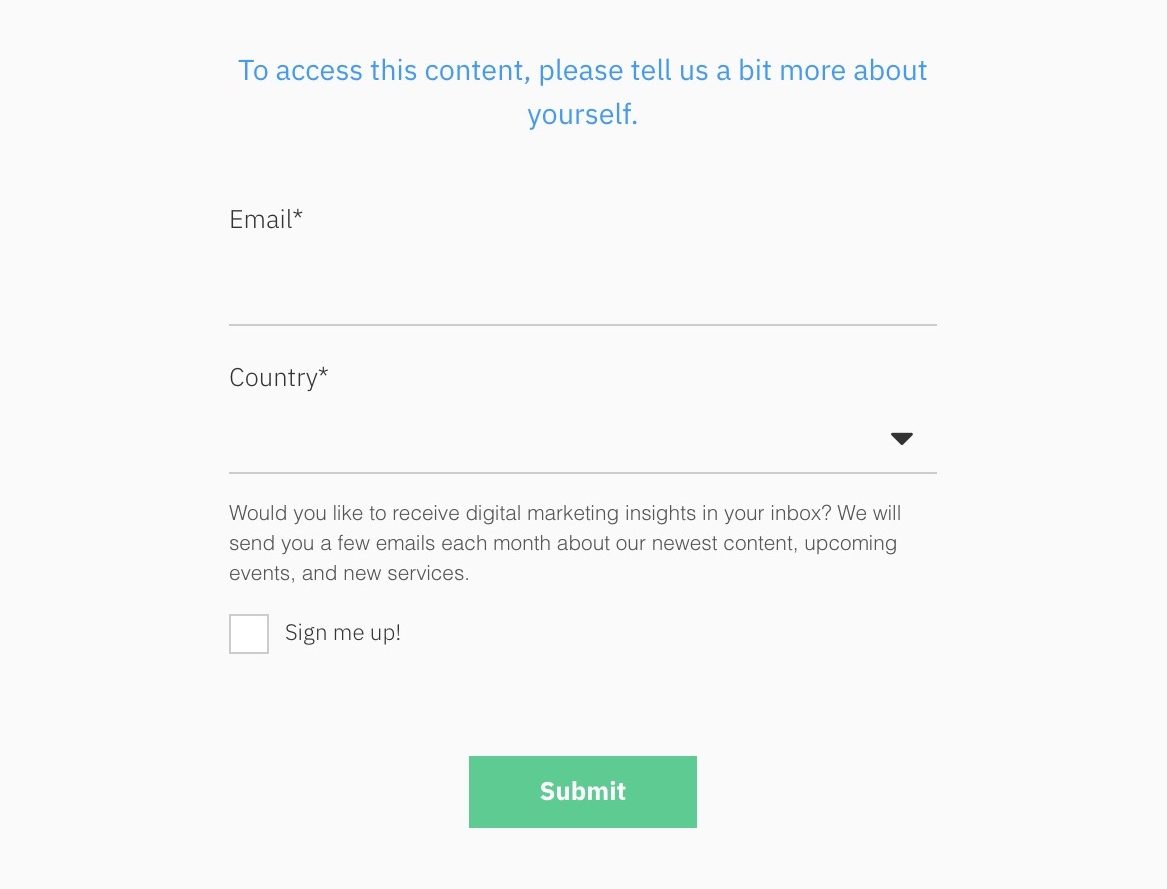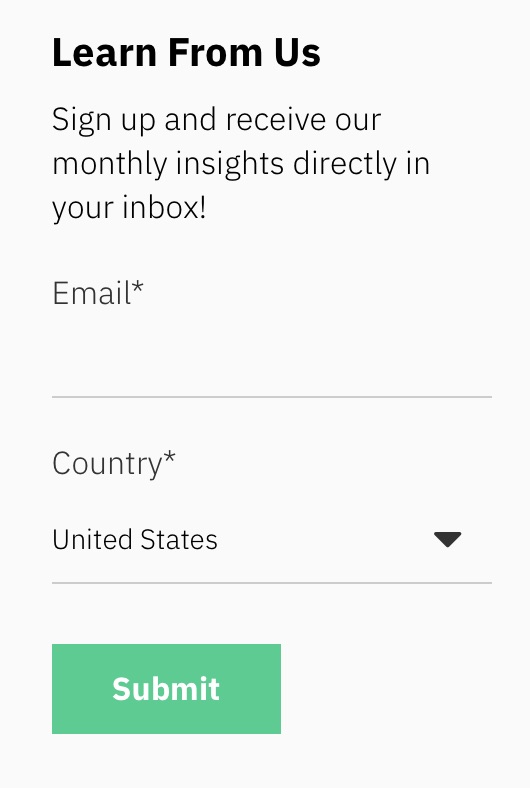By now, everyone understands that email marketing is an important component of the digital marketing landscape. Email marketing allows you to nurture leads and stay in front of your contacts on a regular basis. But a successful email marketing strategy relies heavily on the quality (and size) of your email marketing list. The truth is that building a marketing list is often more difficult than actually implementing an email marketing strategy.
Most firms who are just getting started with email marketing begin with very few email addresses on their lists. The first order of business for these firms is to grow their lists with quality contacts. After all, it would be a waste of energy (and more than a little deflating) to go to the effort of orchestrating a full-fledged email marketing program all for a small handful of followers.
4 Key Tactics for Growing Your Email Signup List
There are four key tactics that you should use to grow your email list via email signups.
- Create content to generate traffic
- Have at least one call-to-action (CTA) on every page
- Produce premium content
- Keep your forms simple
Create quality content to generate traffic
You’re probably sick of hearing that content creation is the answer to all your digital marketing questions. But if your firm is not regularly creating new, insightful, and educational content for people to consume, what reason would your prospects have to visit your site and sign up for your email list? No one wants updates on a firm they don’t know or care about. Maybe that’s harsh, but you have to create content in some way, shape, or form to succeed at digital marketing.
Attracting visitors to your website is the first (and one of the most important) steps to increasing email subscribers. You can attract visitors through organic or paid channels. Either way, the content has to be there – and it has to be good. The better your content is, the more traffic you’ll attract and eventually convert, regardless of the origin of the traffic.
Once you get traffic to your site, you need to show them your expertise. Give them a reason to opt in to your list. Utilize your content strategy to answer common questions that your target audience often asks. Become a voice of influence in your niche market. By creating great content on a regular basis, you’re providing your visitors with real value. That value – not your sales pitch or a writeup of your most recent company party – is what will prompt them to opt in to your email lists and learn more from you.
Have at least one call-to-action on every page
Once visitors are coming to your site to consume your expert content, you need to give them opportunities to engage. Every single page on your website should have at least one relevant call-to-action. A call-to-action (CTA) is an image or text that prompts your visitors to take action. Examples of CTAs that lead to conversions are:
- Email signup form
- Content upgrade
- White paper
- Webinar registration
- Past webinar download
- Get in touch
See Chris Butler’s article, The Five Essential Prospect Engagement Points to learn how to engage visitors with the right calls to action and forms.
Produce premium content
In order to have at least one relevant CTA on every page of your site, you need to produce premium content. Premium content is content behind a form that should offer more value to the visitor than an average blog post. If you don’t have premium content on your site, you are limiting the number of conversion opportunities. Without premium content, the only conversion points are to your email signup and contact forms.
It’s wonderful when a prospect simply comes to your site and submits a contact form. But a visitor who submits a contact form is already primed for a sales conversation. Remember that one of the primary purposes of email marketing is to guide leads through the sales funnel. Plus, most firms don’t have enough contact form submissions to sustain a business development plan. Even if you’re getting plenty of opportunity through your contact form now, that won’t always be true if you don’t have or maintain a content strategy.
If a visitor lands on your site and isn’t ready to submit a contact form, they won’t necessarily just sign up for your email. Most people aren’t online trying to find more ways to fill up their inbox. This is why we’ve never been in favor of an email signup form popping up as soon as a visitor lands on your site, especially when the popup takes up the entire screen.
People are more likely to sign up to receive emails when it’s in conjunction with something they’re interested in being able to access immediately. This is why it is important to have premium content on your site. Premium content allows you to create CTAs that are highly topical, which means that site visitors who share an interest in that topic are much more likely to convert on it. The more premium content you produce, the more targeted, topical CTAs you can include on your site.

Premium content allows you to create CTAs that are highly topical while also
encouraging users to opt-in to receive your digital marketing emails.
Content upgrades are a great example of topically relevant CTAs. Content upgrades are bonus content that people can access in exchange for their email address. In one test we ran, articles with content upgrades had a 12.33% conversion rate compared to those with more generic sidebar CTAs, which had a 0.303% conversion rate. Let’s say you get 1,000 visitors to an article on your site. With a content upgrade, you could get 120 conversions compared to just 20 with more generic sidebar CTAs. Plus, content upgrades tend to be easier for firms to produce than white papers, ebooks, and webinars.
Keep your forms simple
To optimize your conversion rate, you should keep your forms simple. This is especially true for marketing forms. Embracing progressive profiling is key to reducing friction and getting all the necessary information from visitors. Progressive profiling enables your site to remember previously submitted information about a visitor to then display and capture new form fields on subsequent conversions.
Here’s an example of the Newfangled Email Signup form. In this case, we are only requesting email and country. The country field is pre-filled based on the user’s IP address with the option to change. Presenting fewer fields related to the action helps increase conversions and generate more leads.

Newfangled takes a different approach than many when it comes to the first two required fields. Instead of the first name, we request the country. This is because data collection and email regulations vary by country. We opt to collect country over name in order to be compliant with GDPR and regulations that may come out in the future in other countries.
Why email opt-ins are important for a successful email marketing strategy
Building a list of email opt-ins is critical to establishing and maintaining a strong outbound email strategy. It is important that your list is comprised of people who are interested in your communication, know to expect it, and whose first impression will be trust, not apprehension. But this is not just a courtesy to the email audience, it’s also a benefit to the sender. Getting expressed permission yields better open and engagement rates, reduces spam complaints, and preserves sender reputation.
Your website plays an important role in growing your marketing list. Follow the four tactics outlined in this article to optimize your site for conversions and facilitate a strong email strategy.
